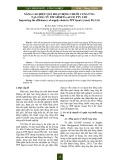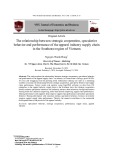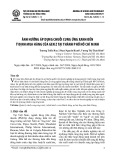
* Corresponding author
E-mail address: 181220009@stu.gedik.edu.tr (S. Ghorbani)
© 2019 by the authors; licensee Growing Science, Canada
doi: 10.5267/j.uscm.2018.12.005
Uncertain Supply Chain Management 7 (2019) 417–426
Contents lists available at GrowingScience
Uncertain Supply Chain Management
homepage: www.GrowingScience.com/uscm
A study on relationship between financial performance and supply chain in the accepted
companies in Borsa Istanbul
H. Şaduman Okumuşa, Shahryar Ghorbanib* and Serpil Karatepeb
aProf.Dr.H.Saduman Okumus, Department of International Trading and Finance, Faculty of Economic, Management and Social
Sciences, Istanbul Gedik University, Turkey
bPhd Student in Management and Business Administration Programme, Graduate School of Social Sciences, Istanbul Gedik University,
Turkey
C H R O N I C L E A B S T R A C T
Article history:
Received October 11, 2018
Accepted December 12 2018
Available online
December 14 2018
The lack of a proper communication link between supply chain operations and financial
performance seems to be due to the difficulty of using the operational metrics of supply chain
measurement to reach the financial goals. This study is an attempt to find the effect of supply
chain management (SCM) implementation on the financial success of the firms. The study
considers the effects of Revenue, Prime Cost, Cash-to-cash cycle period and Return on working
capital on the financial performance of the selected firms listed in Istanbul stock exchange from
2012 to 2017. The study divides the sample size based on their financial growth into two groups
and using some statistical test measures the difference between two groups, statistically. The
results show that there was a significant difference between the mean of high-growth and low-
growth companies in terms of SCM implementation. However, the effects of cost, cash cycle and
working capital on financial performance were not confirmed.
ensee Growin
g
Science, Canada
by
the authors; lic9© 201
Keywords:
Supply Chain Management
Financial Success
SCOR Model
Value Creation
1. Introduction
Nowadays, competition among business units is based on the production of goods and services
according to customer needs (Aitken et al., 2003; Broz et al., 2018). In addition to the globalization and
escalation of competition in the international arena along with technological advancements,
competition has led to the formation of a new business environment to create opportunities for bigger
success (Fisher et al., 1997; Ballou et al., 2000). As a result many companies have moved toward the
customer process in order to reduce the amount of time taken to meet customer needs as well as
providing better interaction with their suppliers to gain competitive advantages, as they realize that in
a closed environment they cannot continue to survive (Beamon, 1999). This procedure led to a shift in
the direction of companies’ view to supply chain processes as a critical activity increasing value
creation for customers (Lai et al., 2002). Supply chain management (SCM) consists of different
approaches and effectively integrates suppliers, manufacturers, distributors and customers to make
long-term performance improvement of individual companies and the whole supply chain in a
comprehensive, high-performance business model (Chopra & Meindl, 2007). Supply chain

418
management involves the design and management of all procurement and activities, conversion and all
procurement management activities as well as coordination and collaboration with existing partners in
the network (Holland et al., 2006; Cao & Zhang, 2011). It also suggests that supply chain management
involves dealing with one of the most important differences between supply chain decisions and
financial investment outcomes (Huang et al., 2008). Since the cost and quality of service sold directly
is associated with the purchase services, supply chain management and its related strategies are very
important for the success of any firm (Davis, 2005). Therefore, supply chain policies, such as supplier
selection, play a key role on the success of the firms (Hartley & Choi, 1996; Arifin et al., 2019). Lean
practices contribute to the internal processes of any firm, along with the principles of just in time (JIT)
from other known methods in SCM (Barge et al., 2006). SCM integrates the internal processes of the
firms and the customers form the basis of the whole ideas embedded in SCM. With the widespread
application and usage of the Internet, Web-based systems help organizations form a strong type of
customer relationship management (CRM) (Scott & Westbrook, 1991; Frohlich & Westbrook, 2002;
Asiyanbi & Ishola, 2018).
While interest in implementing SCM procedures and strategies in organizations is increasing, many of
the existing knowledge and practices in this field are limited only to financial domains such as purchase,
procurement, information technology and marketing but little research has been accomplished in
relationship with its operational implementation and financial performance improvement (Gardner &
Lambert, 2006). However, some operational metrics have been developed over time, which links the
processes and activities of the supply chain to financial performance. The relationships among all the
measures of operational and financial measurements have to be determined (Ellram & Cooper, 1990).
The identification of these criteria helps transform financial objectives into operational criteria, and
intermediate managers can use these criteria into their operational activities rather than the
organization. On the other hand, knowledge of the effect of processes on operational and financial
metrics can be used to enable supply chain performers to evaluate the profitability of the business unit
(Ketzenberg et al., 2008). Hence, identifying the relationships between supply chain metrics and firm
financial success may fill the gap between the operational and financial perspectives of SCM. In
addition, establishing a connection between supply chain management and financial aspect is a
necessity to reach success in business development. Thus, in order to develop and implement SCM
practices, the need to participate in the company's top management and business units will be felt under
its set. While senior financial officials consider the company’s financial success as a result of the growth
in revenue and profit of each share, effective and efficient use of assets such as cash circulation, capital
circulation, or cash from operations maximize the value of shareholders' wealth and SC managers may
address issues such as timeliness, equity, and forecasting of reliability and other qualitative materials
(Carter & Liane Easton, 2011).
Today, most senior decision-maker managers have accepted that SCM plays essential role on the
success of the organization's operations. From 1997 to 2000, a study by an international research team
from the DB Schenker and Stanford universities revealed that the SCM had been critically essential
element in about 10% of the communities investigated. In another study, Kaya and Azaltun (2012), the
firms with high supply chain firms represented a better profit, equity returns, and profit margin.
Nevertheless, little research has been accomplished on how to influence the impact of SCM practices
on the financial success of firms. In this study, we intend to investigate the relationship between SCM
practices and the financial success of the company using experimental data. The structure of the paper
is that in the second and third section, the theoretical foundations and methodology of the research are
studied and then, in the fourth section, the findings are discussed. The fifth section is also devoted to
concluding and expressing the results of the research.

H. Ş. Okumuş et al. / Uncertain Supply Chain Management 7 (2019)
419
2. Literature review
First we define the role of SCM that plays in the financial Success of an organization. The planning,
organization and control of activities in the supply chain are called supply chain management (Chen et
al., 2015). According to Cooper et al. (1997) “SCM is an integration processes that provides services
and information, these result can be creation of added value for customers and other stakeholders. These
processes include customer procurement, stock control, and transportation management, such as non -
traditional procurement activities such as purchase, support from production, packaging, and order of
the customer order”.
SCM can be seen as a simple of an evolutionary and cumulative innovation, often referred to as
originating frominternal programs aimed at improving the overall effectiveness (Saad, 2002). The focus
of SCM can increase interests in insider the organization, reduces the non-value-added processes and
creates value among all components of the supply chain (New & Ramsay, 1997). This major emphasis
on integration strongly leads to the development of effective and long-term relationships between
buyers and suppliers (Spekman, 1991). With the above definitions of SCM, it can be concluded that
SCM can be described as the management of allactivities associated with transferring goods from raw
materials to the consumer. It involves selection of the resources and supplies, production scheduling,
order processing, inventory management, transfer, storage, and customer service (Burgess et al., 2006).
The view that stakeholders own the company, which is why the business unit is responsible for them is
not a new issue. The value of any business unit can be increased through four different methods:
revenue increase, reduced operating costs, reduction of capital in circulation, and increased
productivity, for example an initiative with a focus on reducing inventory level may lead to the the
sales loss level, and the benefits of this initiative can be easily measurable. However, the long-term
growth requires an increase in revenue and managers have to concentrate on all four expressed methods
to increase the value of the firm (Lambert et al., 2005). Therefore, attention to stakeholders for
managers decision-making is that the same increase in firm value is a positive net present value for
future earnings streams by increasing shareholder value (Krause et al., 2009).
The main strategies that arise with regard to increasing shareholder value are three operational,
investment and financial strategies. The operational strategy helps improve economic efficiency,
reduce operating costs, or through improvement in effective use of resources, leading to improvements
in profitability. Investment strategies such as updating at the capacity of production and technological
processes lead to overall improvement at the firm's performance level. Financial strategies are called
strategies to raise funds through issuance of shares or debts. In this regards paying dividends and
restructuring are financial models that corporate managers can use to increase shareholder value, so the
adaption of these strategies have to maximize the shareholders’ wealth (Thomas et al., 2011).The
measurement of financial performance to assess the success of SCM success is very critical. Since it
makes it easy to understand behavior, thereby improving competitiveness. However there seems to be
a missing link between measuring the daily operations of the supply chain and the financial
performance of the missing ring (Dugato et al., 2015).
While many qualitative criteria include measures of customers satisfaction, flexibility, integration of
information and materials, effective risk management and supplier performance, other metrics such as
inventory circulation, profit Margin and cash to cash circulation are easily obtained (Otto & Kotzab,
2003). Identifying the implications of stakeholder's value in order to make decision about procurement
category and the importance of the expected return has always been an implicit concept among financial
goals (Pettit et al., 2010). In the supply chain study using the measurement of company products,
services, process and comparing them with successful benchmark companies is a relevant concept
(Christopher, 1998). Previous studies on the benchmark chain has shown that as the managers compare
their practices on competing firms, this may lead to increase productivity in the supply chain.
Gradually, the benchmark has become the best way of analysis because of the combination of
quantitative metrics with qualitative procedures. Such a model allows managers to talk more

420
confidently about issues such as whether they are favorable or not to change the organization's business
performance, improve the predictable performance, achieve and measure it (Stewart, 1997).
3. Research methodology
This section explores the introduction of methodology, including the extension of hypotheses, selecting
criteria, statistical sample, data collection, and data analysis techniques.
3.1. Research hypotheses
The supply chain management framework in this study states that SCM practices have a direct impact
on the financial success of the firms. The SCM practices are expected to increase the financial success
of a firm through its total capital market value. It is defined financially that it can increase the growth
rate of the market value of its assets, which is the fundamental purpose of maximizing shareholders’
value. In this study, we are looking to answers the following questions:
R1: Is there any relationship between companies with better supply chain management and financial
success?
To answer this question, the following assumptions are set:
H1: There is a significant difference between financial success of the firms with high sales growth and
low sales growth.
H2: There is a significant difference between financial success of the firms with high cost and low cost.
H3: There is a significant difference between financial success of firms with shorter cash flow recycling
cycle and companies with a higher cash recycling cycle.
H4: There is a significant difference between financial success of firms with high productivity rates and
firms with low productivity rates.
Then, in the next section, we examine the following question:
R2: Which of the four SCM criteria has a greater impact on financial success?
In order to identify this, the following hypothesis is stated:
H5: Investors consider the supply chain components in their assessment when evaluating the stock.
To measure this hypothesis, the following regression model is used:
011223344iiiiii
Yxxxx
, (1)
where i
Y (Financial success)represents the dependent variable, 1i
x
to 4i
x
represent the independent
variables, 0
to 4
are coefficients to be estimated and i
denotes the residuals. The independent
variables include Revenue (X1), which is an index for the reliability, accountability and flexibility in
SCM. X2 represents Prime Cost as a percentage of revenue, which is also as an index for cost attribute
in SCM. X3 denotes the time of the cash-to-cash cycle period which is an index for the management of
the assets of SCM assets. Finally, X4 represents the return on working capital, which is an index for the
assets management attribution to SCM.

H. Ş. Okumuş et al. / Uncertain Supply Chain Management 7 (2019)
421
3.2. Selection criteria
The most important benefits of the Supply Chain Operation Reference (SCOR) model is that the
standard processes provide definitions for the relationship between processes, performance metrics and
set standards (Chan et al., 2003). This framework can be effectively used by financial managers to
convert financial goals into operational metrics so that middle managers can be able to use these criteria
into operational activities rather than the organization. This framework can help supply chain managers
in knowledge of the impact of processes on operational and financial metrics in order to assess the
operational and financial effects of the changes being carried out within the organization. It tries to link
operational metrics to the value of shareholders (Tang & Tomlin, 2008). The SCOR model consists of
three levels (See Table 1).
Table 1
Linking SCOR model performance metrics to the financial performance factors
Increasing the return of the capital
Custome
r
-Facing Internal-Facing EVA
Com
p
onents
SCOR Level 1 Reliability Responsibility Flexibility Cos
t
Assets
Perfect Order Fulfillmen
t
√
Revenue
Order Fulfillment Cycle Time
√
Upside Supply Chain Flexibility
√
Upside Supply Chain Adaptability
√
Downside Supply Chain Adaptability
√
Cost
Supply Chain Management Cost
√
Cost of Goods Sold
√
Cash-to-Cash Cycle time
√
Return on Supply Chain Fixed Assets
√
Assets
Return on Working Capital
√
First Level defines the range and content of the supply chain using five basic level processes (plan,
resource, construction, delivery and return). At the second level, the supply chain configuration is
determined by using a bundle of processes. Processes are aligned with operational strategies at this
stage. At the third level, the flow diagram is defined by using elements of the process or specific tasks
of each previous level processes (Reddy et al., 2008). The above model supports five supply chain
functions: the reliability of delivery of goods, responsibility, flexibility, supply chain costs and asset
management efficiency. Table 2 shows summarizes the definitions.
Table 2
The performance characteristics of the supply chain
Row Index Name Definition
1
Reliability
Supply chain performance is appropriate for proper delivery, at the right time, to the appropriate
location, availability and packaging, in appropriate quantity and volume, with appropriate
documentation and customer.
2 Responsibility The supply chain speed in delivering products to the customer.
3 Flexibility Supply chain agility in response to market changes to gain or maintain competitive advantage
4 Cost Costs related to supply chain operations
5 Efficiency
The effectiveness of an organization in managing assets and property in order to support the demand
response, It includes all types of assets, including fixed assets and circulation assets
In this study, we use the following variables defined by the SCOR model to measure the dependence
between the performance metrics of the supply chain performance and financial success of the firm.
Market Value (Y) is measured as the number of common shares issued per year multiply by stock price
at the end of financial year. X1 is the revenue which is a criterion for reliability, responsiveness and
flexibility. Our first measure of supply chain is an increase in revenue, which is an indicator of the
characteristics of reliability, the responsiveness and the mobility of the supply chain. A key component
of successful management involves the integration of downstream customers with high suppliers'

![Sổ tay Hướng dẫn phát triển chuỗi cung ứng [Chuẩn nhất]](https://cdn.tailieu.vn/images/document/thumbnail/2025/20251007/kimphuong1001/135x160/26201759828896.jpg)


![Tổng quan môn học Quản trị logistics kinh doanh: [Thông tin chi tiết/Hướng dẫn/Tài liệu]](https://cdn.tailieu.vn/images/document/thumbnail/2025/20250604/nganga_00/135x160/624_tong-quan-mon-hoc-quan-tri-logistics-kinh-doanh.jpg)













![Đề kiểm tra Quản trị logistics [mới nhất]](https://cdn.tailieu.vn/images/document/thumbnail/2025/20251015/2221002303@sv.ufm.edu.vn/135x160/35151760580355.jpg)
![Bộ câu hỏi thi vấn đáp Quản trị Logistics [năm hiện tại]](https://cdn.tailieu.vn/images/document/thumbnail/2025/20251014/baopn2005@gmail.com/135x160/40361760495274.jpg)






